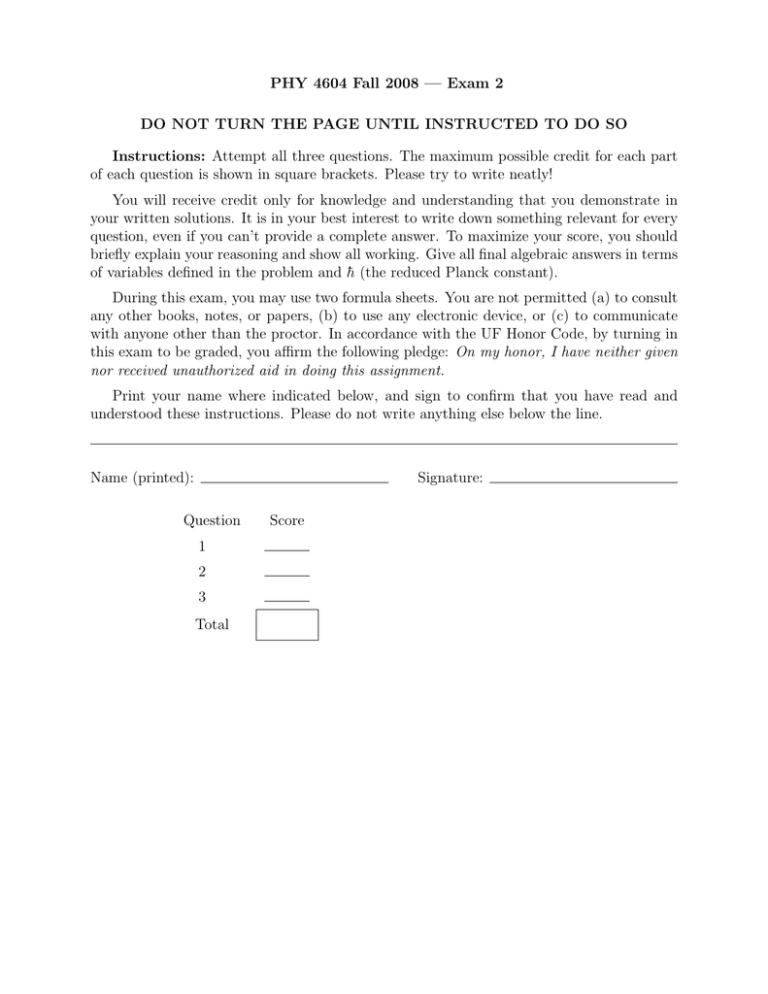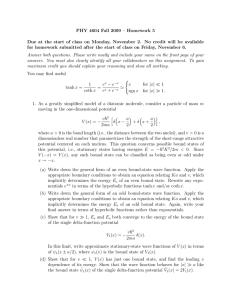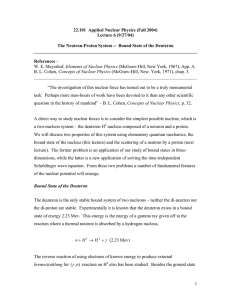PHY 4604 Fall 2008 — Exam 2 Instructions:
advertisement

PHY 4604 Fall 2008 — Exam 2
DO NOT TURN THE PAGE UNTIL INSTRUCTED TO DO SO
Instructions: Attempt all three questions. The maximum possible credit for each part
of each question is shown in square brackets. Please try to write neatly!
You will receive credit only for knowledge and understanding that you demonstrate in
your written solutions. It is in your best interest to write down something relevant for every
question, even if you can’t provide a complete answer. To maximize your score, you should
briefly explain your reasoning and show all working. Give all final algebraic answers in terms
of variables defined in the problem and h̄ (the reduced Planck constant).
During this exam, you may use two formula sheets. You are not permitted (a) to consult
any other books, notes, or papers, (b) to use any electronic device, or (c) to communicate
with anyone other than the proctor. In accordance with the UF Honor Code, by turning in
this exam to be graded, you affirm the following pledge: On my honor, I have neither given
nor received unauthorized aid in doing this assignment.
Print your name where indicated below, and sign to confirm that you have read and
understood these instructions. Please do not write anything else below the line.
Name (printed):
Signature:
Question
1
2
3
Total
Score
1. [14 points total] A particle of mass m moves in one dimension under the potential
V (x) = −F x, where F > 0 is real.
(a) [5 points] Write down the Schrödinger wave equation for the momentum-space
stationary state of energy E.
(b) [5 points] Solve the wave equation from part (a) to obtain the momentum-space
wave function in terms of one unknown constant. You may assume without proof
that the solution
of the differential equation dy/dx = f (x) y can be written y(x) =
Rx
y(0) exp[ 0 f (x0 )dx0 ].
(c) [4 points] Show that the momentum probability density in this state is independent of momentum.
2. [40 points total] A particle of mass m moves in one dimension under the real-valued
potential V (x) = V1 Θ(x) − aV0 δ(x), where a > 0 and V0 > 0, but V1 may be of either
sign. Θ(x) = 0 for x < 0 and Θ(x) = 1 for x > 0.
(a) [6 points] Write down the form of the bound-state wave function ψ(x) in the
regions x < 0 and x > 0. You may leave in your answer any unknown amplitude
that may have a nonzero value in a physically acceptable state. All other symbols
that don’t appear in the statement of the problem should be defined.
(b) [12 points] By applying the appropriate boundary conditions, obtain an equation
relating the bound-state energy E to other quantities defined above. Express your
answer in the form f (E) = constant.
(c) [10 points] Determine the range of V1 over which a bound state exists.
(d) [12 points] Find the bound-state energy E in closed form. You should be able to
eliminate all square roots from the equation you found in (b) by squaring both
sides, then carrying some terms from one side to the other side before squaring
again. For V1 = 0, the energy should reduce to E = E0 = −ma2 V02 /(2h̄2 ), the
standard result for a pure delta-function potential V (x) = −aV0 δ(x).
3. [46 points total] A quantum-mechanical system is described by a two-dimensional vector space spanned by orthonormal basis vectors |1i and |2i. Here, |1i and |2i are
eigenvectors of an observable operator Ĝ with eigenvalues g1 = γ and g2 = 2γ, respectively. The Hamiltonian for this system is Ĥ = 2 (|1ih1| + |2ih2|)+3i (|1ih2| − |2ih1|).
Both γ and are positive.
(a) [6 points] Express Ĝ and Ĥ as matrices in the basis {|1i, |2i}.
(b) [12 points] Find the eigenvalues E1 and E2 of Ĥ and express the corresponding
eigenkets |E1 i and |E2 i as linear combinations of |1i and |2i. (It is advisable to
check your answers by calculating Ĥ|Ej i using the outer-product form of Ĥ.)
(c) [20 points] At time zero, the system is described by a state vector eiπ/3 |1i. What
are the possible outcomes of a measurement of the observable G performed at
time t > 0? Give the probability of each outcome.
(d) [8 points] For the situation described in (c), at what times t > 0 could the measurement be performed to maximize the expectation value of G?
2









